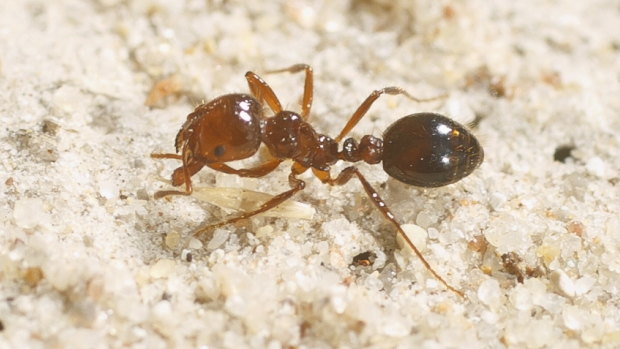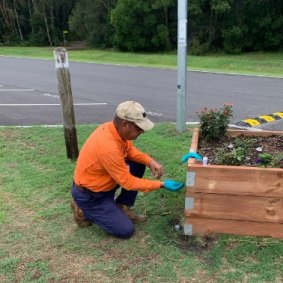This was published 1 year ago
Businesses in lockdown as fire ants found further south in NSW
By Sarah McPhee and Amber Schultz
Businesses are in lockdown and an emergency biosecurity order is in place following the discovery of a fire ant nest in NSW’s Northern Rivers region about 100 kilometres south of the Queensland border.
The red fire ant nest was detected by the NSW Department of Primary Industries at Wardell, south of Ballina, on Friday. It was destroyed on Saturday with the infestation chemically eradicated.

A file photograph of a red imported fire ant.
The biosecurity control order was put in place with immediate effect on Saturday afternoon, restricting movement within the surrounding five-kilometre area of the site.
The order prevents local businesses from moving landscaping, gardening and building materials or machinery until it is inspected by officials.

NSW government response team destroying fire ant nest detected in Wardell, south of Ballina.Credit: NSW Department of Primary Industries
The ants are no longer considered a risk to the community living in the immediate area.
Agriculture Minister Tara Moriarty said the Department of Primary Industries team would continue to work alongside sniffer dogs to determine the extent of any infestation, as well as undertake genetic testing of the fire ants.
“Our teams were prepared for this discovery of fire ants south of Ballina and immediately implemented our response plan and destroyed the fire ant site,” she said.
The discovery of the nest was made by a gardener who was bitten and suffered blistering and pain after disturbing the nest while working. It’s the furthest south the ants have ever been discovered.
The discovery comes two months after fire ant nests were detected for the first time in the state, at South Murwillumbah, 13 kilometres south of the Queensland border.
NSW Farmers President Xavier Martin called on the government to immediately ramp up control and eradication efforts.
“Red imported fire ants are a threat to agricultural production and to the landscape of NSW – they can damage agricultural equipment, sting livestock, ruin the natural environment, and pose a serious risk to the health and wellbeing of all people in NSW,” he said.
“This latest outbreak is a stark reminder of the failure to control and eradicate these insidious pests.”
Invasive Species Council advocacy manager Reece Pianta said she had long feared the earlier outbreak would spread.
“This is a very alarming development. The government must spare no expense in responding to this outbreak and the whole community should treat this very, very seriously,” she said.
“Fire ants are one of the world’s worst super pests and, if they are allowed to spread across the continent, their economic impact will be greater than cane toads, rabbits, feral cats and foxes combined.
“They will devastate Australia’s environment and agriculture, cost our economy billions annually, and we could see over 140,000 extra medical visits every year as they sting Australians at the park or in the backyard.”
Ballina Greens MP Tamara Smith said she was concerned the ants were linked to construction materials and workers who had travelled from Queensland as part of the flood rebuild efforts, and called for all construction sites established since then to be inspected.
“It’s going to keep heading south and what it means for our farmers, for our community and our safety is horrendous,” she said.
Jali Local Aboriginal Land Council representative Kylie Jacky said the Cabbage Tree Indigenous community, who were relocated to Wardell following the floods, were likely to be affected. The community has been living in temporary demountable pods since the disaster.
“The compounding trauma of these events means we need to expedite as a matter of urgency getting our community members who were impacted by the floods back into permanent homes,” she said.
Fire ants are an invasive species, known to become aggressive when disturbed and sting repeatedly. Their sting can kill people, pets and livestock and destroy native ecosystems.
They are dark reddish-brown and range in size from two to six millimetres long. Their nests are described as mounds or flattish patches of soil with no obvious entrance holes, standing up to 40 centimetres high.
Shadow Minister for Agriculture David Littleproud warned current federal funding levels of $268 million over four years was not enough.
“The whole country has been put at risk of fire ants because Labor was too slow to act,” he said.
There are strict rules around the movement of goods such as soil, organic mulch, hay, turf and compost over the border and in controlled areas, as they are considered fire ant carriers.
The Northern Rivers community has been encouraged to report potential fire ant sites via the NSW Biosecurity Hotline at 1800 680 244 or online at dpi.nsw.gov.au/fire-ants.
Further information about the Wardell incident is expected after a detailed examination of the site.
Start the day with a summary of the day’s most important and interesting stories, analysis and insights. Sign up for our Morning Edition newsletter.